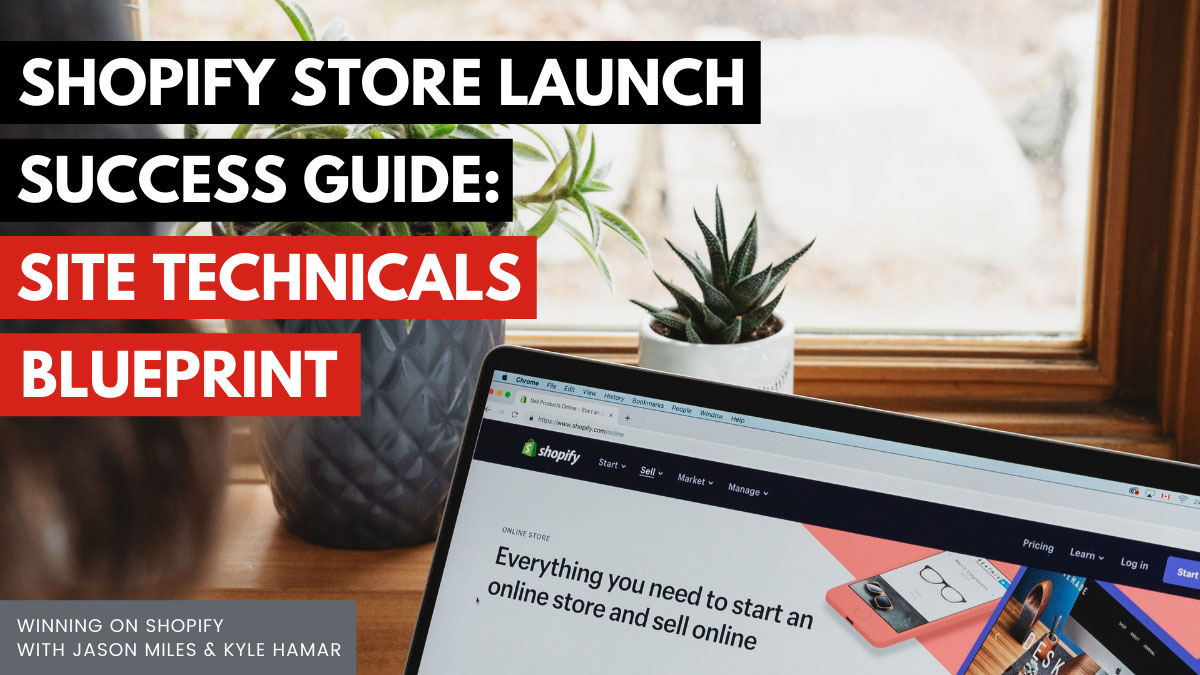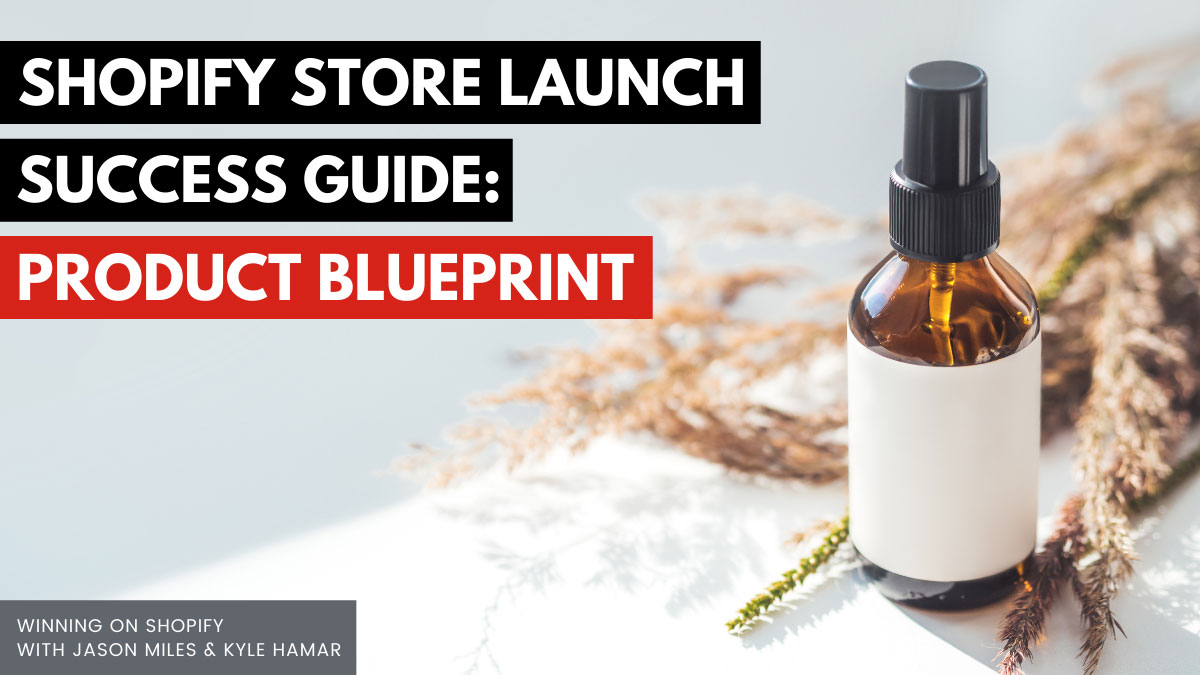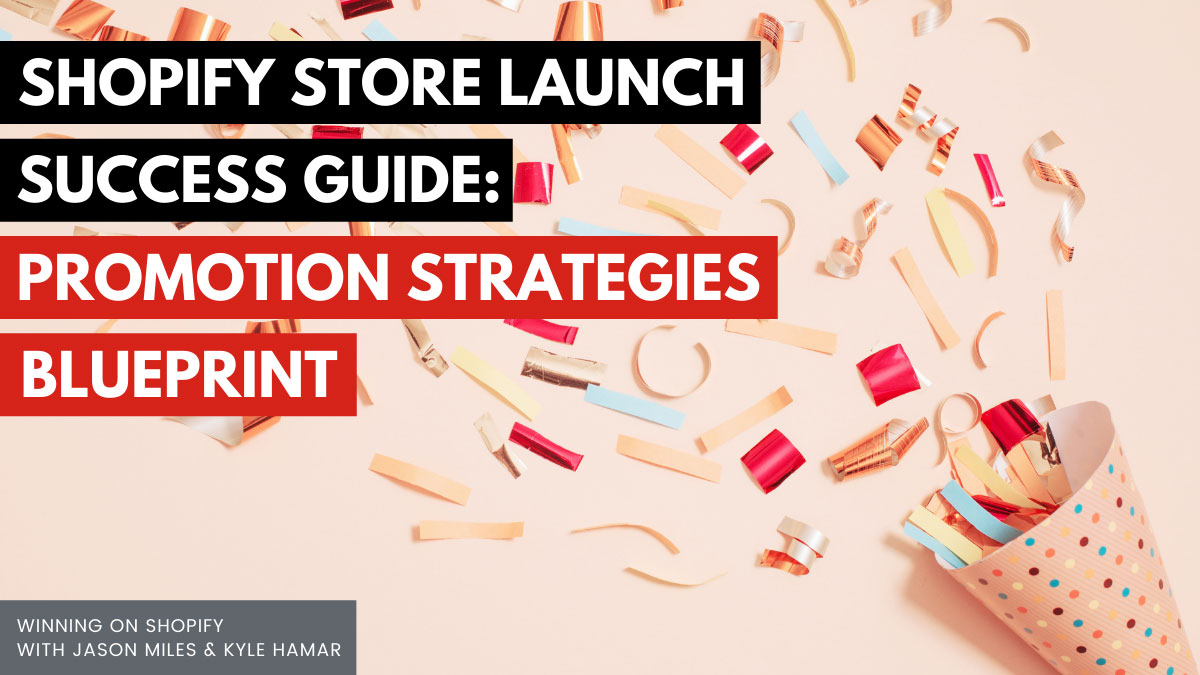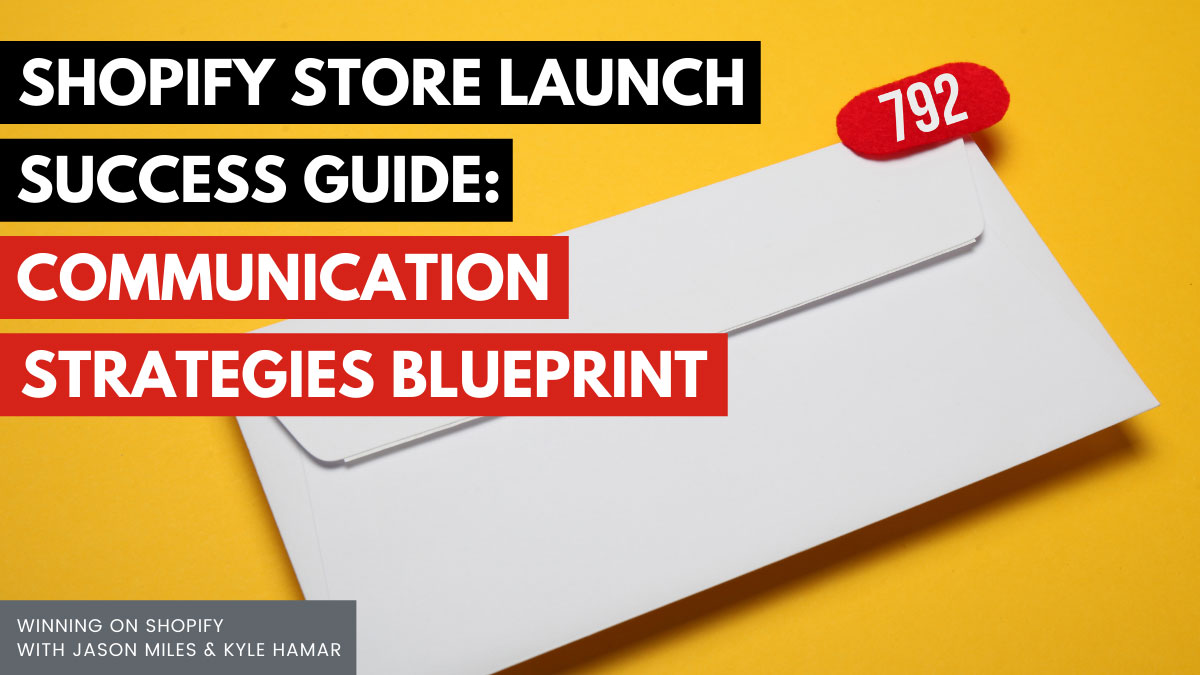Shopify Store Launch Success Guide (Part One)

Hi friends,
We're excited to share Part One of our 4-Part Shopify Store Launch Guide!
If you followed our initial Shopify Store Launch Success Guide Introduction post, then you've picked a date for your Shopify store launch. If you haven't done that yet, then choose a date, put it on the calendar, and make a public announcement so you have some peer pressure to hold you accountable.
Today's post assumes you are 24 days away from your launch. It will give you specific instructions about what to do in our four areas under review:
- Site Technical Setup: How ready your site is for "real" customers.
- Product Plan: How complete your product strategy is.
- Promotion Strategies: How you are going to draw a crowd to your site for the launch (and beyond).
- Communication Plan: How you'll announce your promotion to your friends, followers, and even new prospects.
Readiness Assessment: Since we're just starting our work. Let's talk about your readiness to launch. Use the following chart to evaluate your readiness based on these four topics.

Use your own gut feeling about how to rank your readiness using the 5-Stars. If I were doing it - I'd use something like this:
![]() (I have little to no plan and I'm nowhere near ready)
(I have little to no plan and I'm nowhere near ready)
![]() (I've set up some things, but still have a lot to do)
(I've set up some things, but still have a lot to do)
![]() (I've done 80% of the work, it's close to ready)
(I've done 80% of the work, it's close to ready)
![]() (I'm just putting the finishing touches on it - I think)
(I'm just putting the finishing touches on it - I think)
![]() (I'm 100% ready to launch, I think)
(I'm 100% ready to launch, I think)
Plan Templates: You might be saying to yourself - I don't have a plan for these topics, so how can I go from a 1-star readiness to a 5-star readiness? Great question. Here are 4 Launch Blueprints, one for each of our topics:

Site Technicals Blueprint: Use this checklist to ensure you have a solid technical plan for your site launch:
- Top Level Domain: You've most likely built your site using the free ".myshopify.com" URL they provide. But you'll want to own a domain connected to your brand and be prepared to switch over to the new domain on launch day. If you're not sure how to do this, you can read this detailed Shopify article: Custom Shopify Domain Name Setup Guide.
- Apps Installed & Working: Each Shopify store is different and so the App needed will vary. But a very common set of Apps to use include:
- Email Opt-In Pop Ups: We like Privy, but Wheelio is also popular. You can find great options here: Shopify Email Opt-In Apps.
- Loyalty Program: Be sure you've got a loyalty program designed and an app installed that supports it. We like S Loyalty, but there are lots of good options. Shopify Loyalty Apps.
- Product Upsell: Work through your product strategy to determine which product should be upsold (especially tying an upsell to your most popular products). We like Bold Apps Product Upsell, but there are several good choices. Shopify Upsell Apps.
- Product Reviews: Make sure you set up product review options. There are lots of options. Shopify Product Review Apps.
- Site Photography: Okay, photos aren't a "technical issue", but they are still incredibly important. If you don't have stunning product images - you need to find a professional photographer or take your own high caliber photos. You'll also want to consider the homepage and category photos - and how they can ensure your site looks incredibly professional.
- Site Copywriting: As with photos - copywriting isn't a "technical issue" per se, but it's incredibly important. You need to audit your site for copywriting and ensure every product has great wording. Double check to make sure that each of these pages are well written:
- Product Pages
- About Me Page
- Return Policy Page
- Privacy Policy & Terms Of Service Page (Legally required and templates are available from Shopify here).
- FAQ Page
- Contact Page
- Any other customer facing page.

Product Blueprint: A solid product strategy is a central part of a successful Shopify store. If you're familiar with our Shopify Growth Hacking Workbook then you'll recognize the phrase, "Magnetic Product". They are fairly rare, so brace for that reality check. You won't find these on Alibaba. If they were common there would be a lot less stress on entrepreneurs.
But they are available in every niche, every category, and for every unique customer. They hide, but sometimes in plain sight. Your job is to hunt hard to find them. So let's outline the attributes of these mystical creatures.
- Problem Solver: A product that solves a real problem for a specific customer. It might be an entertainment product like a toy, a hobby product, technology, educational product or personal care item. The list is endless, but the concept is a requirement. If it isn't a "must have" product for some core audience, then it is not a good magnetic product. Fad products that are popular in the short-term, but aren't attractive to a core audience for the long-term are not ideal. Consider them a reject, even though you might be able to sell a lot of them in the short-run.
- Loyalty Creator: Your Magnetic Product has to be attractive to your ideal customer - there is no other way around it. Some products simply don't create strong loyalty. If your customer is indifferent about which seller they work with each time they return to make another purchase, you have a serious problem.
- Money Maker: There are a lot of products that customers expect to get for free and that is fine if you're affordably offering free products to the right customers. That's a great way to build a following. There are also a million products you can sell for near zero profit. Those are not good Magnetic Products. Your Magnetic Product has to be a product that your ideal customer is in the habit of spending money on and that you can make a good profit on. More on this later in this chapter.
- Get-Able: Your Magnetic Product must be readily available to you in large quantities for the long-term. A product that you cannot easily produce or procure is not a Magnetic Product. If it is very difficult to get - then it's likely not a good candidate. Ideally, you'll have unique access to a scarce supply.
- Defensible: Your Magnetic Product must not be readily available to your competition in large quantities for the long-term. Yes, this creates one of the most challenging aspects of creating a Magnetic Product. If you cannot offer some unique elements, some exclusive aspect, some component that only you have access to and can offer customers, then you're going to have a hard time defending your turf for the long-term. Your long-term business economics are tied directly to the ability to create a moat that the competitors cannot cross. Keep reading, we'll show you how to do this in the next few pages.
- High Margin: The math related to one of your individual product items is called the "Unit Economics". You cannot afford to play any games at this level. Your Magnetic Product must have good unit economics or it's not a good Magnetic Product. Period. End of story. The only exception to this rule is if your Magnetic Product is part of an integrated product suite, where the profit comes from another related product that is easily sold to your customer. This can be a path that leads to profit.
- Purchased Frequently: The frequency with which people purchase the product is incredibly important as well. It is very hard to market a product that is very infrequently purchased because the total customer value is likely very low, since it is tied to just the one-time purchase. Magnetic Products are repurchased frequently.
- High Price Point: Your price point is something to spend a lot of time considering. I have a catalog of over 1,700 items that sell for less than $12 on my site, and I can promise you - it's a hard road. So even having a $19, $39, or $99 priced product can help tremendously. Over time you'll likely come to find that having a range of products with a range of prices helps you a lot.
- Pricing Power: Some industries are far more price aware than others. If on the other hand you can pick your prices, test them, and you discover that customers aren't very sensitive to modest changes, you might have a great opportunity. On the other hand, if you have to keep adjusting your price down to make a sale, then you have a serious problem and the item you're trying to sell is not your Magnetic Product.
- High Switching Cost: One way to create long-term defensibility is to build in high switching costs. When you can do this, you have a fantastic opportunity. Consider the Keurig coffee maker, or Windows operating system. This is a rare opportunity, but in some industries, it can make sense. Define a way of working, or methodology with your Magnetic Product and you've got a shot.
If you don't have a product with these elements, then you need to work hard to find one. Of course, the other option is to make a product yourself either as an ebook or video based course. These digital products have fantastic margins and if your customers enjoy them, you might find them extremely beneficial to your overall product mix.

Promotion Strategies Blueprint: How you're going to promote the launch of your new site - and promote it in an ongoing way is a critical aspect of running your own website. Consider this simple plan:
- Begin planning an online contest giving away one of your best products in exchange for prospects taking social action. The social action is an online action that is completed via a social network - and results in your contest getting more exposure. You can learn how to do this using one of the following tools:
- Plan on running your contests NOW (as soon as possible) even before your store is open. Run it for 7-10 days. Before now and your launch day - do as many back to back contests as you can to gather as much social action as possible. As with all things, the first time will be hard, but it will get much easier after you do it a few times. Contest entries you should consider would include:
- Sign-Up For My Newsletter (use Mailchimp if you don't have an email provider already).
- Follow me on Twitter
- Follow me on Instagram
- Follow me on Pinterest
- Repin an image on Pinterest (that leads back to your contest)
- Visit my Facebook page
- (Any other creative "follow me" type entry method.)
- Share your contest with as many of your existing fans, friends, and followers as you can. Ask them to enter. After your first contest ends, you should have a much larger audience to share the 2nd contest with - do it - invite them to enter to win "again" and invite them to enter by taking the same social actions. This "rinse and repeat" strategy can be used over and over to grow your audience.
- If you are starting with zero friends, fans, or followers in your new niche, then consider promoting your first contest with a paid Facebook ad to target your ideal customers. Simply doing this the first time should be enough to get the snowball of social sharing rolling downhill.
- Begin planning a special promotion for your launch week. Make the grand opening contest extra special - a really big prize. Think about how best to structure it to gain maximum exposure.

Communication Strategies Blueprint: The process of online selling is a two step process. First, have a product to sell. Second, have a way to tell people about it. The communication strategy is your way to tell people. Having a consistent communication strategy is hard work, but generally, once you get a routine established (and you see it working well) it becomes easier to maintain. Consider preparing for your launch by doing the following:
- Learn the best practices for email marketing. If you're not familiar with our Email Marketing For E-commerce course, consider taking it.
- Plan how frequently you'll email your new list. I'd encourage you to consider at least one time a week, on the same day, so your customers get used to it. Maybe two or three times a week is ideal for your customers. You'll have to decide what feels right and then stick to it.
- Plan out on your newsletter "content strategy". In other words, what are you going to say in each newsletter? Maybe one topic would be - news about your most recent contest. Another topic might be "new products". Of course, there is "weekly sale items" and on and on. You get the idea. Decide on your topics ahead of time so you don't have to be "creative" each time you're making a newsletter.
- Prepare to send at least two newsletters prior to your store launch letting your prospects know what you're working on. (Put them on the calendar and commit to sending them). Lay the groundwork by sharing with them the "behind the scenes" effort that is underway. Recruit them as allies in your upcoming launch and let them know you're going to be throwing a massive "website party" and you'd love to have them come - enter the contest(s) and help you spread the word.
- Develop a social media sharing calendar. It can be as simple as - every time you publish a newsletter you share the link to it on Facebook, Twitter, and other social sites.
Take this week to work through these details. They will challange you! Push through the pain and confusion and plow forward! Take these steps and refuse to delay your launch!
Learn More Right Now
Get Our Help - INNER CIRCLE PROGRAM: Get our personal help & insider training. For those of you who want our personal help and support - consider joining our Inner Circle Program where we work with our most successful students. The Inner Circle gives you access personal support. You also get access to all our prior training courses as free bonuses. Group members get access to a private Facebook group as well. Learn more here.
SHOPIFY GROWTH HACKING VIDEO COURSE: Our newest Shopify video training is getting fantastic reviews! Get the full video course now - 50% savings. Or get started now by just watching the free promotional videos that are packed with great content. You'll learn how to create a Magnetic Product, Magnetic Brand, Optimize For Net Profit, and Dominate Your Niche!
Free Course - Brand Building For E-commerce: Want even more training and e-commerce branding insights? Get my latest branding course today! And because I'm trying to get 25 5-Star Reviews, I've got a totally free Review Copy coupon for you (only available for a very limited time). All I ask in return is that you actually take the course and leave your highest and best review. Thanks in advance!
Get A Free 30 Minute Consultation When You Apply For Personal Coaching: As part of the coaching application process we offer a free 30 minute consultation. It is our opportunity to meet each other and discover together if coaching is a good fit. If you're ready to get our personal help. Learn more here.
If you'd like additional training and coaching to achieve your Shopify goals, consider applying for our coaching program today!
Grateful for the chance to be of help,
Jason & Kyle


